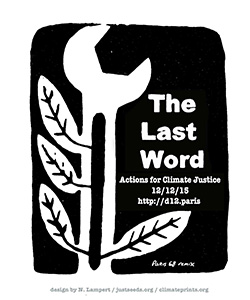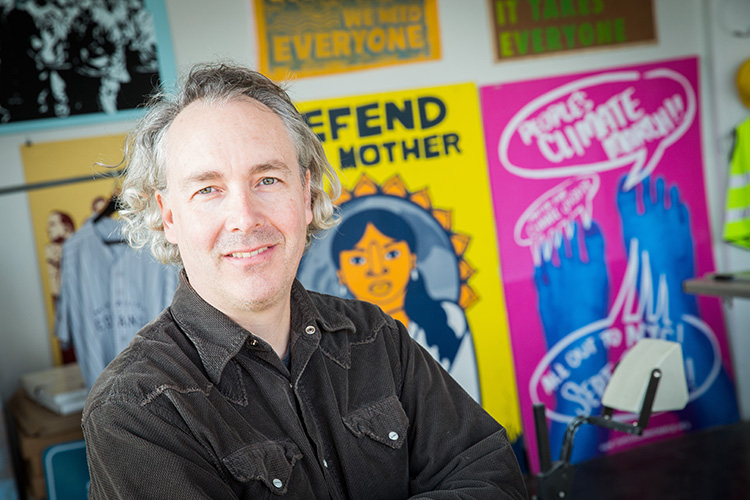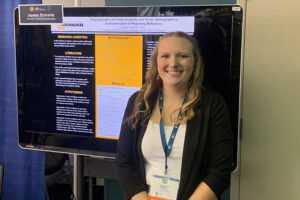What’s a movement today without posters, banners and images for social media campaigns?
Nicolas Lampert, a senior lecturer in art and design, uses art to enhance campaigns for environmental and social justice. A co-founder of Climateprints.org, which enables artists to contribute posters and banners to environmental causes worldwide. He took part last year in the People’s Climate March in New York City and leaves Friday for Paris to be on hand for the international climate summit and related demonstrations taking place there.
How did you begin using art to promote social and environmental justice?
My path has been merging art and environmental activism and social justice for the last 15 to 20 years. I’ve taught seven to eight semesters of art ecology here at UWM. I work with a local group called ReciproCity that merges public art, community art and urban farming. I also work in this decentralized artists’ cooperative called Justseeds Artists’ Cooperative, which is 30 printmakers who are based throughout North America.
How do these groups connect with environmental groups?
About three or four years ago, 350.org, which is one of the major international climate justice groups, reached out to Just Seeds and said they were fans of our work and wondered if we would want to do a project with them. We did and began working on art to help promote the People’s Climate March. Some of us in Justseeds also went to New York City before the march to help create some of the key visuals carried in the march – the banners, inflatable sculptures, signs and other visuals that helped frame the issues being addressed.
Is the fact that the world has become a more visual place – with the Internet, social media and 24/7 television news — driving the need for more artistic involvement?
Yes. The whole climate debate is about ideas. We live in a time period with such short-term memory, and things move so fast, that a powerful icon and image really stands out. So harnessing the power of art on the side of this movement is vital.
How does this environmental and social justice focus impact your work as an artist?
It represents a sea change in my work. It’s so far outside the realm of what I was ever trained to do as an artist. I love galleries and museums, but most people don’t visit those spaces. Their outreach isn’t the same as getting your message in an international newspaper, or getting your art out in a demonstration of 400,000 people, or having it shared on social media all over the world.

How did Climate Prints come about?
In talking with other interested artists, I realized there wasn’t a hub space to pull artists into the climate justice movement. There was not a place where environmental groups could go to easily find artists, to tap into their work. We built this curated site where diverse artists can upload their work, and environmental groups and movements can then download the images for free.
Is that how your poster for Climate Prints came to be used in the November Guardian story about the protests expected at the Paris climate conference?
Yes. It’s bizarre. I’ve read the Guardian for a long time and just to see my image pop up in there was somewhat mind blowing. My image was a takeoff on the posters in the 1968 Paris uprisings, when artists were creating posters overnight and plastering the streets of the city. I wanted to re-adapt the Paris ’68 graphics because I wanted to make the historical connection between what had happened then and the mass mobilization that is happening now.
Why is Paris so important?
It’s a make-or-break conference, a chance for the major industrial countries in the world to own up to the climate crisis. The Copenhagen climate talks at the start of the Obama administration completely failed. This one can’t, but don’t be surprised if it disappoints. Environmentalists are calling this decade zero: we have one decade to fundamentally change the energy structures of the world – one decade to make sure temperatures do not eclipse 2 degrees Celsius or we’re in serious trouble. We are already at a tipping point. This year has been the hottest year on the historical record. The carbon dioxide levels in the atmosphere are hitting 400 parts per million; the safest level is 350 ppm.
How have the recent terrorist attacks in Paris changed demonstrators’ plans?
The French government has prohibited street demonstrations of two or more people, while still allowing sporting events to happen. A massive march at the start of the conference that was expected to draw over 200,000 people has been cancelled.
But, a recent migrant rights’ demonstration of 1,500-plus people challenged this restriction; it speaks volumes that many undocumented people were the first to speak out.
The problem with the government’s clamp down is that you need a people’s movement to put pressure on world leaders to sign a meaningful compact. You need people to push from below. That is how change is best manifested. You don’t want heads of states to have the last word on climate change — leaders from Venezuela, Saudi Arabia, Russia essentially preside over oil and gas states. They are not going to advocate for the environment. Obama will be pressured by the fossil fuel lobby to ease back on his demands. I am traveling to Paris to network and collaborate with a host of international artists and environmentalists. It is crucial for people speak out. And it is key for artists to join this chorus.







